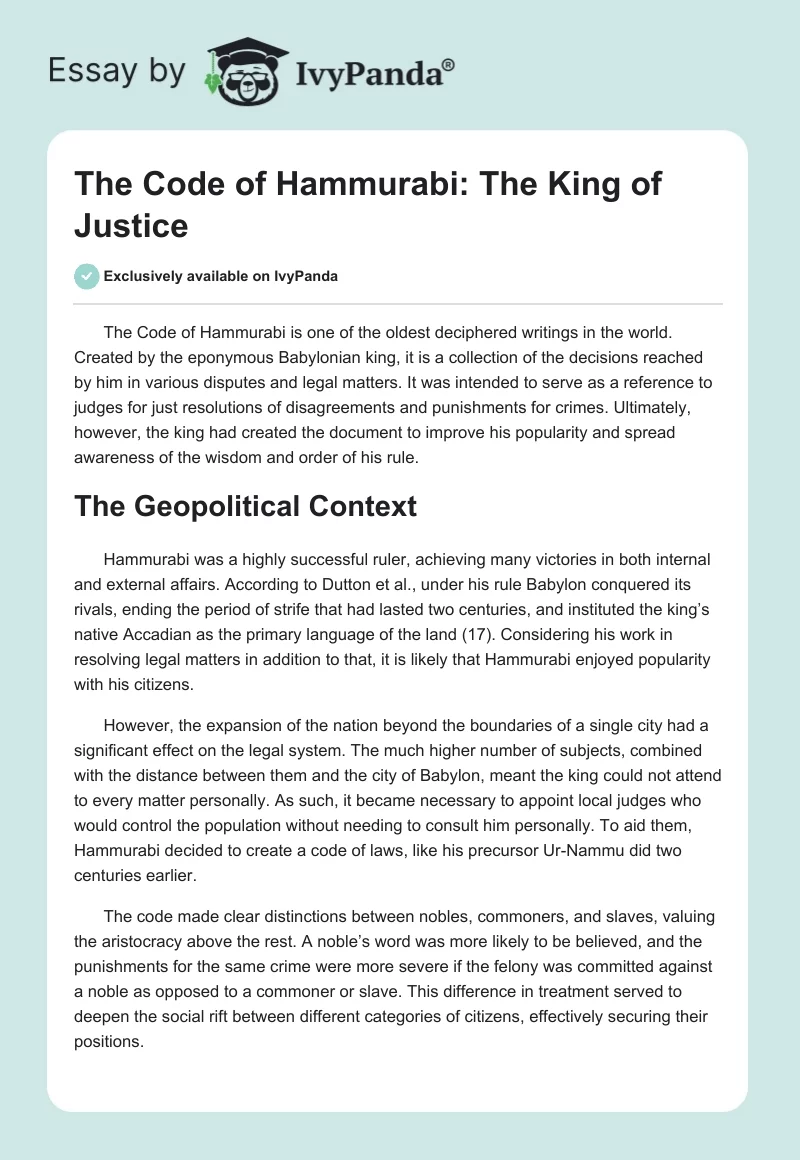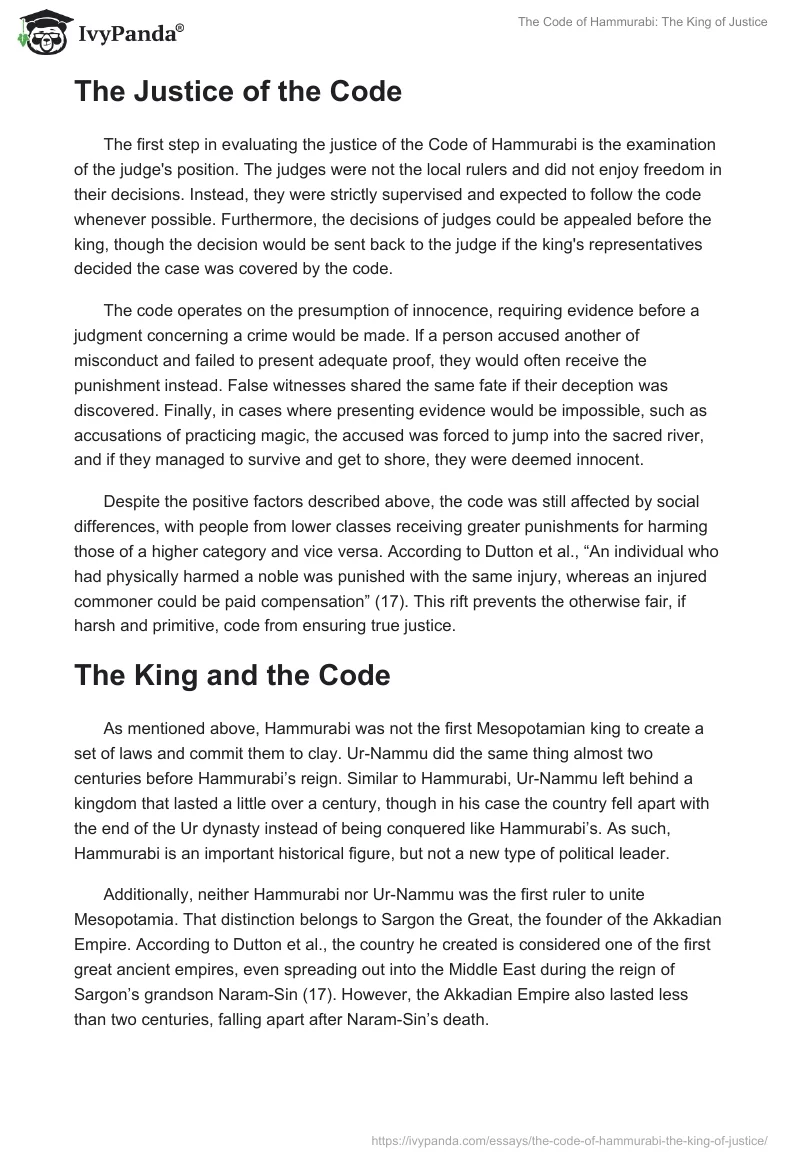The Code of Hammurabi is one of the oldest deciphered writings in the world. Created by the eponymous Babylonian king, it is a collection of the decisions reached by him in various disputes and legal matters. It was intended to serve as a reference to judges for just resolutions of disagreements and punishments for crimes. Ultimately, however, the king had created the document to improve his popularity and spread awareness of the wisdom and order of his rule.
The Geopolitical Context
Hammurabi was a highly successful ruler, achieving many victories in both internal and external affairs. According to Dutton et al., under his rule Babylon conquered its rivals, ending the period of strife that had lasted two centuries, and instituted the king’s native Accadian as the primary language of the land (17). Considering his work in resolving legal matters in addition to that, it is likely that Hammurabi enjoyed popularity with his citizens.
However, the expansion of the nation beyond the boundaries of a single city had a significant effect on the legal system. The much higher number of subjects, combined with the distance between them and the city of Babylon, meant the king could not attend to every matter personally. As such, it became necessary to appoint local judges who would control the population without needing to consult him personally. To aid them, Hammurabi decided to create a code of laws, like his precursor Ur-Nammu did two centuries earlier.
The code made clear distinctions between nobles, commoners, and slaves, valuing the aristocracy above the rest. A noble’s word was more likely to be believed, and the punishments for the same crime were more severe if the felony was committed against a noble as opposed to a commoner or slave. This difference in treatment served to deepen the social rift between different categories of citizens, effectively securing their positions.
The Justice of the Code
The first step in evaluating the justice of the Code of Hammurabi is the examination of the judge’s position. The judges were not the local rulers and did not enjoy freedom in their decisions. Instead, they were strictly supervised and expected to follow the code whenever possible. Furthermore, the decisions of judges could be appealed before the king, though the decision would be sent back to the judge if the king’s representatives decided the case was covered by the code.
The code operates on the presumption of innocence, requiring evidence before a judgment concerning a crime would be made. If a person accused another of misconduct and failed to present adequate proof, they would often receive the punishment instead. False witnesses shared the same fate if their deception was discovered. Finally, in cases where presenting evidence would be impossible, such as accusations of practicing magic, the accused was forced to jump into the sacred river, and if they managed to survive and get to shore, they were deemed innocent.
Despite the positive factors described above, the code was still affected by social differences, with people from lower classes receiving greater punishments for harming those of a higher category and vice versa. According to Dutton et al., “An individual who had physically harmed a noble was punished with the same injury, whereas an injured commoner could be paid compensation” (17). This rift prevents the otherwise fair, if harsh and primitive, code from ensuring true justice.
The King and the Code
As mentioned above, Hammurabi was not the first Mesopotamian king to create a set of laws and commit them to clay. Ur-Nammu did the same thing almost two centuries before Hammurabi’s reign. Similar to Hammurabi, Ur-Nammu left behind a kingdom that lasted a little over a century, though in his case the country fell apart with the end of the Ur dynasty instead of being conquered like Hammurabi’s. As such, Hammurabi is an important historical figure, but not a new type of political leader.
Additionally, neither Hammurabi nor Ur-Nammu was the first ruler to unite Mesopotamia. That distinction belongs to Sargon the Great, the founder of the Akkadian Empire. According to Dutton et al., the country he created is considered one of the first great ancient empires, even spreading out into the Middle East during the reign of Sargon’s grandson Naram-Sin (17). However, the Akkadian Empire also lasted less than two centuries, falling apart after Naram-Sin’s death.
Despite Hammurabi’s presumably lesser importance compared to these two, he is better known, primarily for his code. There are two primary reasons to commit a rule to a clay tablet: permanence and time. A law that is written down is immune to changes or misunderstandings that may result from a verbal retelling, letting people feel more secure in their understanding of it. Furthermore, a written law may outlive its creator, continuing to see use during the reign of their successors and immortalizing the lawmaker’s name, as exemplified by Hammurabi.
Conclusion
Hammurabi’s achievements and the creation of his code make him one of the greatest ancient Mesopotamian rulers, but not the most accomplished of them all. The primary reason for his popularity is his creation of a surviving document that is also an advanced code of laws. The Code of Hammurabi is highly innovative for its time, leaving behind many tribal traditions, operating on the presumption of innocence, and providing judges with a robust framework while restricting their power. However, the remaining tribal customs such as eye-for-an-eye practices as well as the social division prevalent throughout the codes prevent it from creating true justice as defined by modern standards.
Work Cited
Dutton, Paul, et al. Many Europes: Choice and Chance in Western Civilization. McGraw-Hill Education, 2014.


